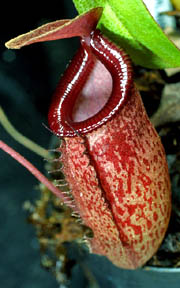
In the Garden![]()
Michael Miyashiro
Easier than thought
Nepenthes cultivation
The Nepenthes, or tropical pitcher plant as it is called, has become a popular garden novelty found in many home landscapes and greenhouses. These carnivorous plants fascinated me when I was a youngster, and now, as an adult, I still feel like a kid again when I see them growing.

|
I only use tap water and haven't observed any areas where chlorine/fluorine is a problem. Of course, our water is harder (high alkaline concentration) than in other areas, but this can usually be neutralized naturally when used with an acid media, such as coming into contact with peat and peat byproducts.
Many textbooks claim that some species that originate at low-elevation climates (less than 1,000 feet from sea level) are the only ones that will grow in our warm tropical climate. Others originating in intermediate to high elevations (2,000 to 3,000 feet) won't grow here. I have observed that this does not always hold true. There are "intermediates" that can grow well in both climates, and I have found that even some high-altitude species will thrive in our lower elevations. Hybrids of high-elevation species will grow well at sea level and produce traps while its parents simply try to survive here.
Pitcher Plant Cultivation in HawaiiWhen: 10 a.m. to noon Aug. 21Where: Ward Warehouse (between Rainforest and Chowder House), 1050 Ala Moana Call: 591-9999
|
Fertilizer is not generally recommended, but I find a dilute liquid fertilizer applied every month at one-eighth strength actually helps growth and activity of these plants. Avoid fertilizers with a high salt content (e.g. Miracle Gro) and use as a foliar/root spray solution.
Fertilizers are an excellent source for trace elements and minerals that help keep your nepenthes happy, but be sure to flush out mineral salt buildup by watering your plants regularly and allowing the water to run out from the bottom of your pots. Salt buildup is probably the most prevalent reason for failure in growing nepenthes.
Nepenthes are epiphytes. This means that they actually grow on other plants. Although many start from composted pockets in crevices and on the ground, many mature into vines that clamber up into the trees in search of sunlight.
The variety of species are endless, and hybrids even more extensive. Some just won't grow here, while others grow like weeds. But they all attract attention!

